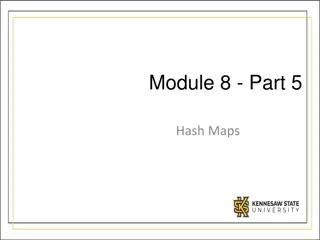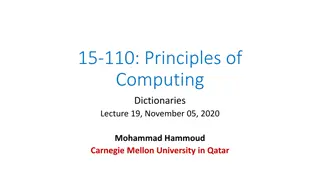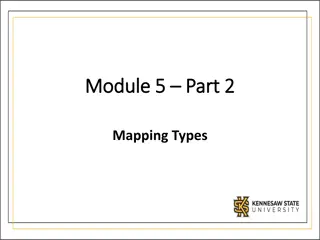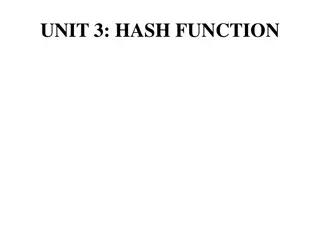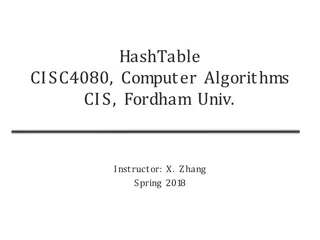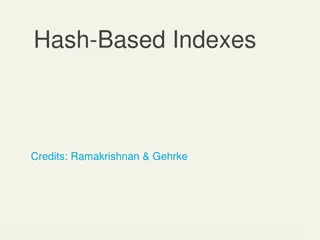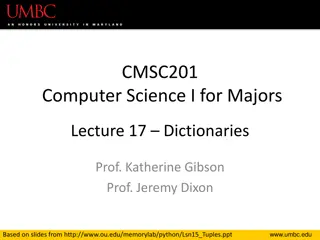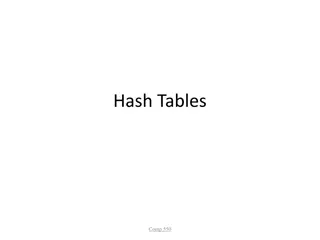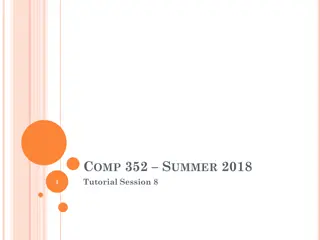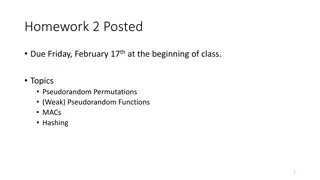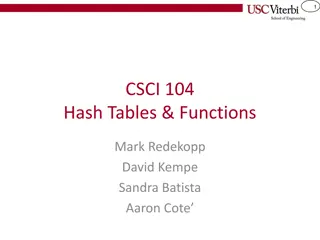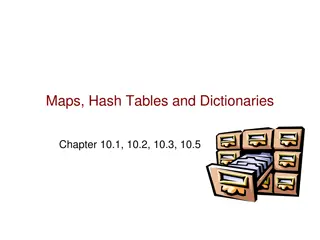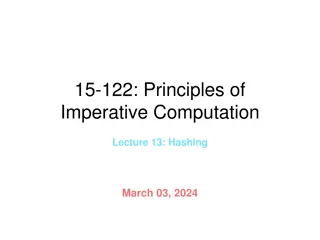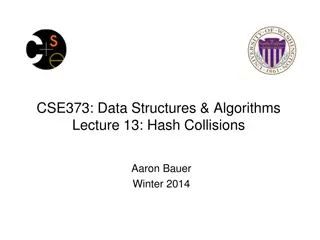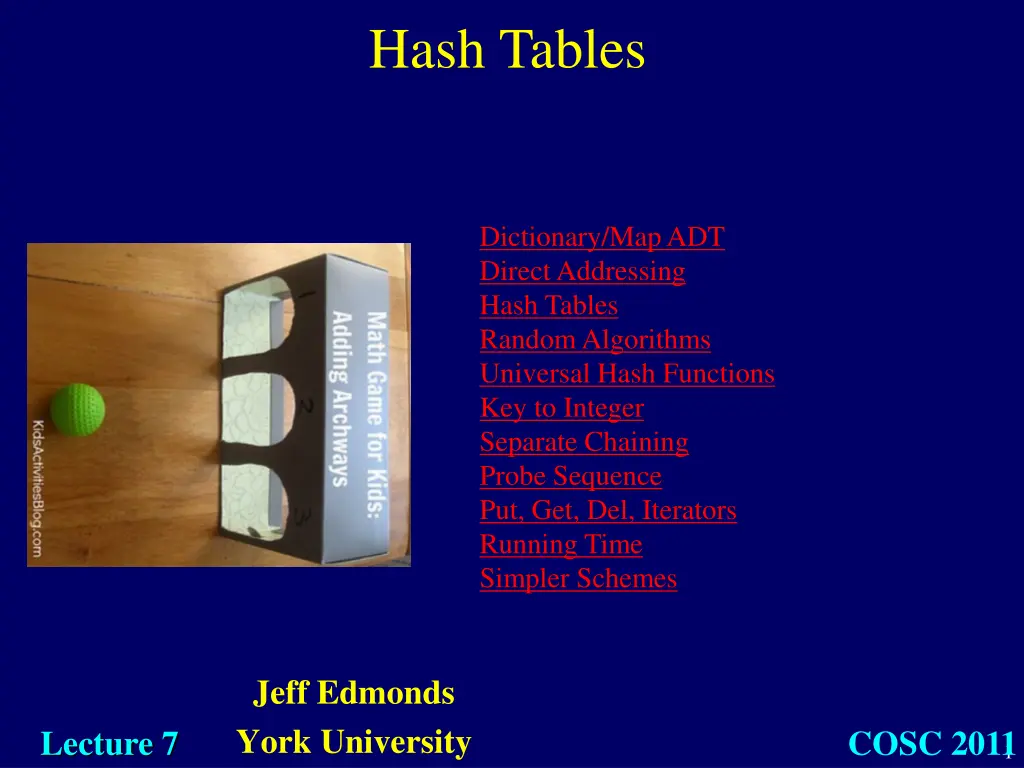
Dictionary and Map ADT Operations Explained with Examples
Explore the concepts of Dictionary and Map ADT, including methods like put, get, remove, and iterators. Learn how to store and retrieve data associated with keys, along with implementation details and running times of various schemes discussed in Jeff Edmonds' lecture.
Download Presentation

Please find below an Image/Link to download the presentation.
The content on the website is provided AS IS for your information and personal use only. It may not be sold, licensed, or shared on other websites without obtaining consent from the author. If you encounter any issues during the download, it is possible that the publisher has removed the file from their server.
You are allowed to download the files provided on this website for personal or commercial use, subject to the condition that they are used lawfully. All files are the property of their respective owners.
The content on the website is provided AS IS for your information and personal use only. It may not be sold, licensed, or shared on other websites without obtaining consent from the author.
E N D
Presentation Transcript
Hash Tables Dictionary/Map ADT Direct Addressing Hash Tables Random Algorithms Universal Hash Functions Key to Integer Separate Chaining Probe Sequence Put, Get, Del, Iterators Running Time Simpler Schemes Jeff Edmonds York University Lecture7 COSC 2011 1
Random Balls in Bins Throw m/2 balls (keys) randomly into m bins (array cells) The balls get spread out reasonably well. - Exp( # a balls a ball shares a bin with ) = O(1) - O(1) bins contain O(logn) balls. 2
Input Dictionary/Map ADT Problem: Store value/data associated with keys. key, value k1,v1 k2,v2 k3,v3 k4,v4 Examples: key = word, value = definition key = social insurance number value = person s data 3
Dictionary/Map ADT Map ADT methods: put(k, v): insert entry (k, v) into the map M. If there is a previous value associated with k return it. (Multi-Map allows multiple values with same key) get(k): returns value v associated with key k. (else null) remove(k): remove key k and its associated value. size(), isEmpty() Iterator: keys(): over the keys k in M values(): over the values v in M entries(): over the entries k,v in M 4
Dictionary/Map ADT Operation isEmpty() put(5,A) put(7,B) put(2,C) put(8,D) put(2,E) get(7) get(4) get(2) size() remove(5) remove(2) get(2) isEmpty() Output true null null null null C B null E 4 A E null false M (5,A) (5,A),(7,B) (5,A),(7,B),(2,C) (5,A),(7,B),(2,C),(8,D) (5,A),(7,B),(2,E),(8,D) (5,A),(7,B),(2,E),(8,D) (5,A),(7,B),(2,E),(8,D) (5,A),(7,B),(2,E),(8,D) (5,A),(7,B),(2,E),(8,D) (7,B),(2,E),(8,D) (7,B),(8,D) (7,B),(8,D) (7,B),(8,D) 5
Input Dictionary/Map ADT Problem: Store value/data associated with keys. key, value Array k1,v1 k2,v2 k3,v3 k4,v4 0 1 2 3 4 5 6 7 k5,v5 Implementations: Search O(n) Insert O(1) Unordered Array 6
Input Dictionary/Map ADT Problem: Store value/data associated with keys. 6,v5 key, value Array 2,v3 4,v4 7,v1 9,v2 0 1 2 3 4 5 6 7 Implementations: Search O(n) O(logn) Insert O(1) Unordered Array Ordered Array O(n) 7
Input Dictionary/Map ADT Problem: Store value/data associated with keys. key, value header 2,v3 4,v4 7,v1 9,v2 6,v5 nodes/positions entries trailer Implementations: Search O(n) O(logn) O(n) Insert O(1) Unordered Array Ordered Array Ordered Linked List O(n) O(n) Inserting is O(1) if you have the spot. but O(n) to find the spot. 8
Input Dictionary/Map ADT Problem: Store value/data associated with keys. key, value 2,v3 4,v4 7,v1 9,v2 38 25 51 17 31 42 63 4 21 28 35 40 49 55 71 Implementations: Search O(n) O(logn) O(n) Insert O(1) Unordered Array Ordered Array Ordered Linked List Binary Search Tree O(n) O(n) O(logn) O(logn) 9
Input Dictionary/Map ADT Problem: Store value/data associated with keys. key, value 5,v1 9,v2 2,v3 7,v4 Hash Tables are very fast, but keys have no order. Implementations: Next O(n) O(1) O(1) Search O(n) O(logn) O(n) Insert O(1) Unordered Array Ordered Array Ordered Linked List Binary Search Tree Hash Tables O(n) O(n) O(logn) O(1) (Avg) O(n) O(logn) O(1) Avg: O(1) 10
Input Direct Addressing key, value Suppose your array was REALLY big. 5,v1 9,v2 2,v3 7,v4 7,v4 4,v5 5,v1 9,v2 2,v3 Array 0 1 4,v5 7,? 2 3 4 5 6 7 8 9 Where would you store 5,v1 ? Called Direct Addressing Implementations: Next Search Insert O(1) Direct Addressing O(1) O(1) 11
Input Direct Addressing key, value Consider the universe of all possible keys. Universe of Keys 0 1 2 3 4 5 6 7 8 9 5,v1 9,v2 2,v3 7,v4 Array 0 1 The Mapping from key to Array Cell is 1-1 2 3 4 5 6 7 8 9 2,v3 4,v5 5,v1 Called 7,v4 Direct Addressing 9,v2 Implementations: Next Search Insert O(1) Direct Addressing O(1) O(1) 12
Input Direct Addressing key, value Consider the universe of all possible keys. Universe of Keys 0 1 2 3 4 5 6 7 8 9 k2= 5,v1 9,v2 2,v3 7,v4 Array 0 1 The Mapping from key to Array Cell is 1-1 If most keys are used, then is a fine data structure. 2 3 4 5 6 7 8 9 2,v3 k3= 4,v5 k5= k1= k4= 5,v1 Called 7,v4 Direct Addressing 9,v2 Implementations: Next Search Insert O(1) Direct Addressing O(1) O(1) 13
Input Direct Addressing key, value Consider the universe of all possible keys. Universe of Keys 0 1 2 3 4 5 6 7 8 9 k2= 5,v1 9,v2 2,v3 7,v4 Array 0 1 The Mapping from key to Array Cell is 1-1 2 3 4 5 6 7 8 9 2,v3 The keys used are those of your customers. k3= 4,v5 k5= k1= k4= 5,v1 Universe of keys is likely huge. (eg social insurance numbers) Called 7,v4 Direct Addressing 9,v2 Next Search Memory Insert O(1) O(1) O(1) How far is the next key? 14
Input Hash Tables key, value Consider an array # items stored. Universe of Keys 0 1 2 3 4 5 6 7 8 9 The Mapping from key to Array Cell is many to one 0 1 2 3 4 5 6 7 8 9 The keys used are those of your customers. Called Universe of keys is likely huge. (eg social insurance numbers) Hash Function Hash(key) = i 15
Input Hash Tables key, value Consider an array # items stored. Universe of Keys 0 1 2 3 4 5 6 7 8 9 5,v1 9,v2 2,v3 7,v4 7,v4 5,v1 9,v2 2,v3 The Mapping from key to Array Cell is many to one 0 1 5,? 2 3 4 5 6 7 8 9 4,v5 4,v5 Collisions are a problem. Called Hash Function Hash(key) = i Implementations: Next Search Insert O(n) Hash Function O(1) O(1) 16
Input Hash Tables key, value Consider an array # items stored. Universe of Keys 0 1 2 3 4 5 6 7 8 9 5,v1 9,v2 2,v3 7,v4 The Mapping from key to Array Cell is many to one 2,v3 7,v4 0 1 5,? 2 3 4 5 6 7 8 9 4,v5 Collisions are a problem. 9,v2 4,v5 Called Hash Function Hash(key) = i 5,v1 Choose Hash to minimize collisions. Deal with collisions. Implementations: Hash Function 17
Input Hash Tables key, value The algorithm chooses the Hash Function mapping from keys to Array Cell. (Does not depend on input) Universe of Keys 0 1 2 3 4 5 6 7 8 9 9 5,v1 9,v2 2,v3 7,v4 2,v3 7,v4 0 1 5,? 2 3 4 5 6 7 8 9 2 4,v5 4 5 The input I specifies which keys are used. 9,v2 4,v5 7 Algorithm wants few collisions 5,v1 Worst case input wants lots collisions Choose Hash to minimize collisions. Implementations: Hash Function 18
Input Hash Tables key, value The universe of keys is huge compared to the array. Hence, many keys get mapped to each array cell. Universe of Keys 0 1 2 3 4 5 6 7 8 9 287,v1 9,v2 394,v3 482,v4 0 1 583,? 2 3 4 5 6 7 8 9 4,v5 The worst case input I uses keys that all go to the same array cell! 4,v5 9,v2 482,v4 287,v1 394,v3 583,? Choose Hash to minimize collisions. Implementations: Hash Function 19
Input Hash Tables key, value If the keys are social insurance number, Hash(key) = i could be the last digit. Universe of Keys 0 1 2 3 4 5 6 7 8 9 293 183,v1 948 847,v2 039 988,v3 948 475,v4 0 1 948 847,? 2 3 4 5 6 7 8 9 304 382,v5 304 382,v5 293 183,v1 The random input I would have all clients have the different last digits. So few collisions But what is a random input I? 948 475,v4 948 847,v2 039 988,v3 20
Input Hash Tables key, value If the keys are social insurance number, Hash(key) = i could be the last digits. Universe of Keys 0 1 2 3 4 5 6 7 8 9 287 005,v1 923 005,v2 394 005,v3 482 005,v4 0 1 287 005,? 2 3 4 5 6 7 8 9 193 005,v5 The worst case input I would have all clients have the same last three digits. So lots of collisions 4,v5 9,v2 482,v4 287,v1 394,v3 583,? In practice, do you get the worst case input? 21
Input Hash Tables key, value To confuse the worst case input, the mapping Hash(key) = i I choose is ?? Random! Universe of Keys 0 1 2 3 4 5 6 7 8 9 287 005,v1 923 005,v2 394 005,v3 482 005,v4 0 1 287 005,? 2 3 4 5 6 7 8 9 193 005,v5 The worst case input I would have all clients have the same last three digits. 4,v5 9,v2 482,v4 287,v1 394,v3 583,? 22
Probabilistic Algorithms Problem P is computable if & Time(A,I) T A, I, A(I)=P(I) I have an algorithm A that I claim works. Oh yeah, I have a worst case input I for which it does not. Actually my algorithm always gives the right answer and is fast. 24
Probabilistic Algorithms Problem P is computable by a random algorithm if AR(I)=P(I) R, A, I, Remember Quick Sort I have a random algorithm A that I claim works. I know the algorithm A, but not its random coin flips R. I do my best to give you a worst case input I. The random coin flips R are independent of the input. And for EVERY input I, I want the correct answer. 25
Probabilistic Algorithms Problem P is computable by a random algorithm if AR(I)=P(I) R, ExpectedRTime(AR,I) T A, I, Remember Quick Sort I have a random algorithm A that I claim works. I know the algorithm A, but not its random coin flips R. I do my best to give you a worst case input I. The random coin flips R are independent of the input. And for EVERY input I, the expected running time (over choice of R) is great. There are worst case coin flips but not worst case inputs. 26
Probabilistic Algorithms Problem P is computable by a random algorithm if PrR AR(I)=P(I) ExpectedRTime(AR,I) A, I, 2-|I| Remember Quick Sort I have a random algorithm A that I claim works. I know the algorithm A, but not its random coin flips R. I do my best to give you a worst case input I. Some random algorithm might give the wrong answer on exponentially few random coin flips 27
Input Random Hash Functions key, value Fix the worst case input I Universe of Keys 287 005,v1 923 005,v2 394 005,v3 482 005,v4 Choose a random mapping Hash(key) = i 0 1 287 005,? 2 3 4 5 6 7 8 9 287 005 193 005,v5 We don t expect there to be a lot of collisions. 482 005 (Actually, the random Hash function likely is chosen and fixed before the input comes, but the key is that the worst case input does not know the hash function.) 193 005 394 005 923 005 28
Input Random Hash Functions key, value Throw m/2 balls (keys) randomly into m bins (array cells) Universe of Keys 287 005,v1 923 005,v2 394 005,v3 482 005,v4 0 1 287 005,? 2 3 4 5 6 7 8 9 287 005 193 005,v5 482 005 193 005 394 005 The balls get spread out reasonably well. - Exp( # a balls a ball shares a bin with ) = O(1) - O(1) bins contain O(logn) balls. 923 005 29
Universal Hash Functions Choose a random mapping Hash(key) = i We want Hash to be computed in O(1) time. Universe of Keys 0 1 2 3 4 5 6 7 8 9 0 1 2 3 4 5 6 7 8 9 Theory people use Hash(key) = (a key mod p) mod N N = size of array p is a prime > |U| a is randomly chosen [1..p-1] n is the number of data items. The modN ensures the result indexes a cell in the array. a adds just enough randomness. The integers mod p form a finite field similar to the reals. 30
Universal Hash Functions Choose a random mapping Hash(key) = i We want Hash to be computed in O(1) time. Universe of Keys 0 1 2 3 4 5 6 7 8 9 0 1 2 3 4 5 6 7 8 9 Theory people use Hash(key) = (a key mod p) mod N N = size of array p is a prime > |U| a is randomly chosen [1..p-1] n is the number of data items. Pairwise Independence k1& k2Pra( Hasha(k1)=Hasha(k2) ) = 1/N Proof: Fix distinct k1&k2 U. Because p > |U|, k2-k1 mod p 0. Because p is prime, every nonzero element has an inverse, eg 2 3mod5=1. Let e=(k2-k1)-1. Let D = a (k2-k1) mod p, a = D e mod p, and d = D mod N. k1&k2collide iff d=0 iff D = jN for j [0..p/N] iff a = jN e mod p. The probability a has one of these p/N values is 1/p p/N = 1/N. 31
Universal Hash Functions Choose a random mapping Hash(key) = i We want Hash to be computed in O(1) time. Universe of Keys 0 1 2 3 4 5 6 7 8 9 0 1 2 3 4 5 6 7 8 9 Theory people use Hash(key) = (a key mod p) mod N N = size of array p is a prime > |U| a is randomly chosen [1..p-1] n is the number of data items. Pairwise Independence k1& k2Pra( Hasha(k1)=Hasha(k2) ) = 1/N Insert key k. Exp( #other keys in its cell ) = Exp( collision )= Exp(collision) = n 1/N = O(1). k1,k k1,k 32
Universal Hash Functions Choose a random mapping Hash(key) = i We want Hash to be computed in O(1) time. Universe of Keys 0 1 2 3 4 5 6 7 8 9 0 1 2 3 4 5 6 7 8 9 Theory people use Hash(key) = (a key mod p) mod N N = size of array p is a prime > |U| a is randomly chosen [1..p-1] n is the number of data items. Pairwise Independence k1& k2Pra( Hasha(k1)=Hasha(k2) ) = 1/N Not much more independence. Knowing that Hasha(k1)=Hasha(k2) decreases the range of a from p to p/N values. Doing this logp/logN times, likely determines a, and hence all further collisions. 33
Universal Hash Functions Choose a random mapping Hash(key) = i We want Hash to be computed in O(1) time. Universe of Keys 0 1 2 3 4 5 6 7 8 9 0 1 2 3 4 5 6 7 8 9 Theory people use Hash(key) = (a key mod p) mod N N = size of array p is a prime > |U| a is randomly chosen [1..p-1] n is the number of data items. This is usually written a key+b. The b adds randomness to which cells get hit, but does not help with collisions. 34
Key to Integer Choose a random mapping Hash(key) = i Universe of Keys abandon abbreviation ability able about above abroad absence absent absolute If the key is a string a0 a1 an 1. convert to an integer with k = a0+ a1 z+ a2 z2+ + an 1zn 1 for fixed z (computed with ki = an i 1 + zki 1) 35
Key to Integer Choose a random mapping Hash(key) = i Universe of Keys If the key is an object in memory, you can use its address in memory as the key. 36
Handling Collisions Input key, value 394,v1 482,v2 583,v3 Handling Collisions When different data items are mapped to the same cell Universe of Keys 0 1 2 3 4 5 6 7 8 9 0 1 2 3 4 5 6 7 8 9 394,v1 583, v3 482,v2 10 37
Separate Chaining Input key, value 394,v1 482,v2 583,v3 Separate Chaining Each cell uses external memory to store all the data items hitting that cell. Universe of Keys 0 1 2 3 4 5 6 7 8 9 0 1 2 3 4 5 6 7 8 9 394,v1 394,v1 583,v3 583, v3 482,v2 482,v2 Simple but requires additional memory 10 38
A Sequence of Probes Input key, value 394,v1 482,v2 583,v3 Open addressing The colliding item is placed in a different cell of the table Universe of Keys 0 1 2 3 4 5 6 7 8 9 0 1 2 3 4 5 6 7 8 9 394,v1 583, v3 482,v2 10 39
A Sequence of Probes Input key, value 103,v6 Cells chosen by a sequence of probes. Universe of Keys 0 1 2 3 4 5 6 7 8 9 put(key k, value v) i1 = (a k mod p) mod N 583, v3 0 1 5 2 3 4 5 6 7 8 9 Theory people use 290,v4 i1 = Hash(key) = (a key mod p) mod N N = size of array p is a prime > |U| a [1,p-1] is randomly chosen 11 394,v1 1009 832 482,v2 903,v5 NextPrime(1000) = 1009 a key = 832 103 = 85696 85696 mod 1009 = 940 940 mod 11 = 5 = i1 10 40
A Sequence of Probes Input key, value 103,v6 Cells chosen by a sequence of probes. Universe of Keys 0 1 2 3 4 5 6 7 8 9 103,v6 put(key k, value v) i1 = (a k mod p) mod N 583, v3 0 1 5 2 3 4 5 6 7 8 9 290,v4 1 394,v1 This was our first in the sequence of probes. 482,v2 903,v5 10 41
A Sequence of Probes Input key, value 103,v6 Double Hash Universe of Keys 0 1 2 3 4 5 6 7 8 9 to get sequence distance d. put(key k, value v) i1 = (a k mod p) mod N d = (b k mod q) + 1 583, v3 0 1 5 3 2 3 4 5 6 7 8 9 290,v4 A common secondary hash function. d = Hash2(key) = (b key mod q) + 1 q is a prime < N +1 to ensure d 0 b is chosen randomly 1 394,v1 7 482,v2 903,v5 b = 1 10 d = 103 mod 7 + 1= 3 42
A Sequence of Probes Input key, value 103,v6 Double Hash Universe of Keys 0 1 2 3 4 5 6 7 8 9 to get sequence distance d. put(key k, value v) i1 = (a k mod p) mod N d = (b k mod q) + 1 for j = 1..N i = i1 + (j-1) d mod N 3 583, v3 0 1 5 3 2 3 4 5 6 7 8 9 4 290,v4 1 5 394,v1 If N is prime, this sequence will reach each cell. d=3 482,v2 903,v5 2 d=3 10 3 43
A Sequence of Probes Input Stop this sequence of probes when: Cell is empty or key already there key, value 103,v6 Universe of Keys 0 1 2 3 4 5 6 7 8 9 103,v6 3 583, v3 0 1 put(key k, value v) i1 = (a k mod p) mod N d = (b k mod q) + 1 for j = 1..N i = i1 + (j-1) d mod N if ( cell(i)==empty ) cell(i) = k,v return if ( cellkey(i)==k ) vold = cellvalue(i) cell(i) = k,v return vold value 2 3 4 5 6 7 8 9 5 3 4 290,v4 1 5 394,v1 482,v2 903,v5 2 was not there 10 3 44
A Sequence of Probes Input A different key gets different random hash values. key, value 103,v6 115,v7 Universe of Keys 0 1 2 3 4 5 6 7 8 9 115,v7 583, v3 0 1 put(key k, value v) i1 = (a k mod p) mod N d = (b k mod q) + 1 for j = 1..N i = i1 + (j-1) d mod N if ( cell(i)==empty ) cell(i) = k,v return if ( cellkey(i)==k ) vold = cellvalue(i) cell(i) = k,v return vold value 2 3 4 5 6 7 8 9 3 2 290,v4 1 2 394,v1 103,v6 3 482,v2 903,v5 was not there 4 10 45
A Sequence of Probes Input Stop this sequence of probes when: Key is found key, value 103,v6 115,v7 Universe of Keys 0 1 2 3 4 5 6 7 8 9 103,? 3 583, v3 0 1 value get(key k) i1 = (a k mod p) mod N d = (b k mod q) + 1 for j = 1..N i = i1 + (j-1) d mod N if ( cellkey(i)==k ) return(cellvalue(i)) 2 3 4 5 6 7 8 9 5 3 4 290,v4 1 5 394,v1 103,v6 482,v2 903,v5 115,v7 2 10 46
A Sequence of Probes Input Stop this sequence of probes when: Key is found or cell is empty key, value 103,v6 115,v7 Universe of Keys 0 1 2 3 4 5 6 7 8 9 103,? 477,? 2 583, v3 0 1 value get(key k) i1 = (a k mod p) mod N d = (b k mod q) + 1 for j = 1..N i = i1 + (j-1) d mod N if ( cellkey(i)==k ) return(cellvalue(i)) if ( cell(i)==empty ) return not there 2 3 4 5 6 7 8 9 6 5 290,v4 7 5 3 394,v1 103,v6 1 482,v2 903,v5 115,v7 X 6 4 10 47
A Sequence of Probes Input key, value 103,v6 115,v7 103,? 477,? Universe of Keys 0 1 2 3 4 5 6 7 8 9 1 583, v3 0 1 value del(key k) i1 = (a k mod p) mod N d = (b k mod q) + 1 for j = 1..N i = i1 + (j-1) d mod N if ( cellkey(i)==k ) vold = cellvalue(i) cell(i) = empty return(vold) 2 3 4 5 6 7 8 9 Del 583 1 5 290,v4 394,v1 103,v6 482,v2 903,v5 115,v7 10 48
A Sequence of Probes Input Stop this sequence of probes when: Key is found or cell is empty key, value 103,v6 115,v7 103,? 477,? Universe of Keys 0 1 2 3 4 5 6 7 8 9 3 X deleted 0 1 value get(key k) i1 = (a k mod p) mod N d = (b k mod q) + 1 for j = 1..N i = i1 + (j-1) d mod N if ( cellkey(i)==k ) return(cellvalue(i)) if ( cell(i)==empty ) return not there Oops! It no longer finds 103. 2 3 4 5 6 7 8 9 Del 583 5 3 103,? 4 290,v4 1 5 394,v1 103,v6 482,v2 903,v5 115,v7 2 10 49
A Sequence of Probes Input key, value 103,v6 115,v7 103,? 477,? Universe of Keys 0 1 2 3 4 5 6 7 8 9 1 583, v3 deleted 0 1 value del(key k) i1 = (a k mod p) mod N d = (b k mod q) + 1 for j = 1..N i = i1 + (j-1) d mod N if ( cellkey(i)==k ) vold = cellvalue(i) cell(i) = return(vold) 2 3 4 5 6 7 8 9 Del 583 1 5 290,v4 394,v1 103,v6 482,v2 903,v5 115,v7 deleted 10 50

